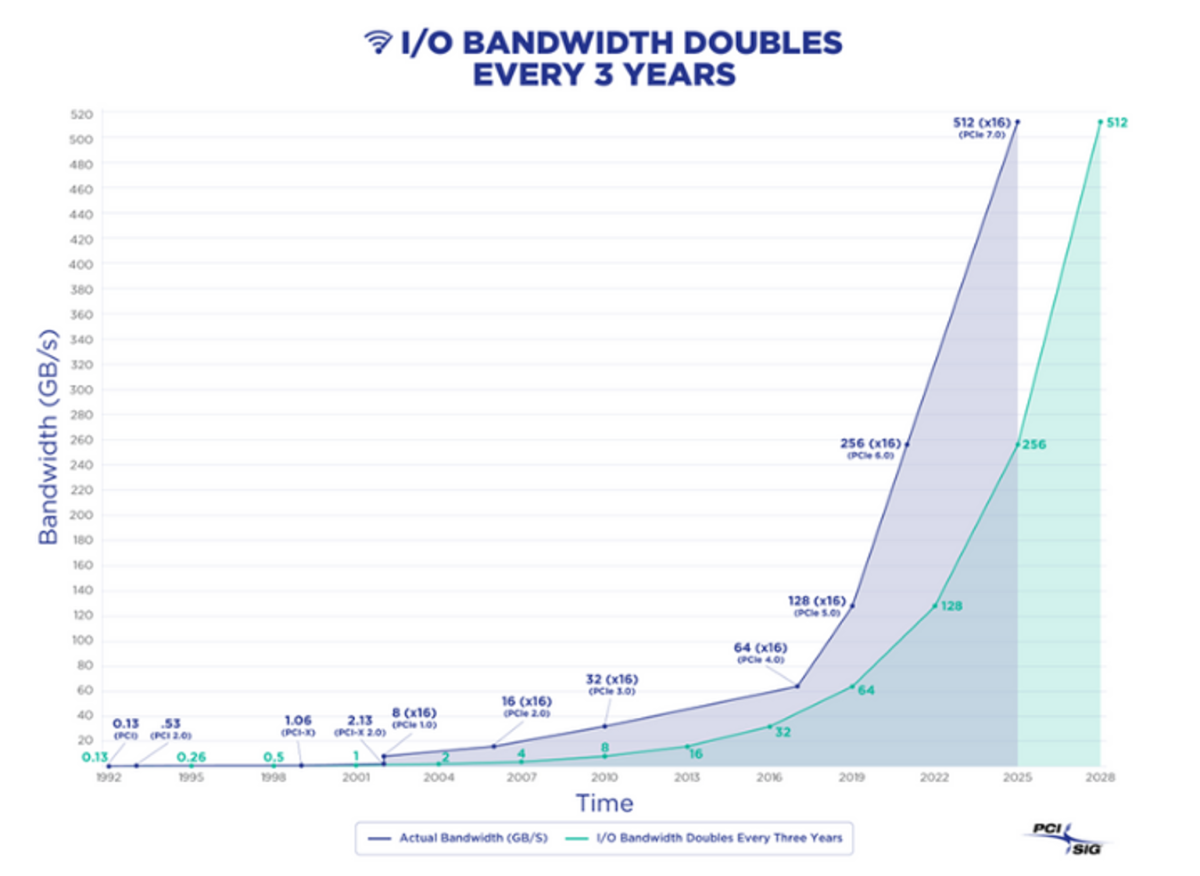Over the past few years, high-end PCs have come to be associated with PCI Express 5.0, the infrastructure that connects graphics cards and SSDs. That’s close to changing, as the PCI Special Interest Group (PCI-SIG) hits a key milestone this year to bring the higher-bandwidth PCI Express 6 to PCs.
Most of the news today from the PCI SIG is theoretical: the SIG has formally announced PCIe 7.0, projected for 2027, and it’s laying the groundwork for PCIe 8.0. Meanwhile, PCI-SIG is even allowing PCI Express to work over optical connections.
That will all make a difference, eventually. But the most meaningful announcement might be the eventual announcement of the PCIe 6.0 integrator’s list, projected to be released in 2025.
Like other industry consortiums, the PCI-SIG works on developing the PCI Express specification with industry partners. The SIG develops its own requirements and then tests each product for compliance. Finally, it publishes its integrators’ list of actual products that have been tested against the specification. Near the top of the current list are AMD’s own 7th-gen Ryzen processors, which followed AMD’s 12th-gen “Alder Lake” chips into the market as the first PC processors with PCI Express 5.0 connections, in 2022.

PCI-SIG
Could the PC shift to PCIe 6 in 2025?
What some forget about the PCI Express SIG is that it moves slowly and on parallel timelines. The final 1.0 specification of PCIe 6 was actually announced in 2022, and the SIG has actually moved on to PCI Express 6.3—even though we haven’t seen a single PCIe 6 product yet. That still signals that the industry has moved past the specification phase and into product development and testing.
Today, the PCI SIG is saying that the first integrator’s list associated with PCI Express 6 is projected for 2025. That implies that the first PCI Express 6.0 processors, chipsets, SSDs, and graphics cards could debut near the end of the year, about the time when Intel’s next-gen Panther Lake chip is expected.
We know, on paper, what PCIe 6 can do: 64 gigatransfers per second, which equates to 64GB/s on the x4 connections that SSDs use and 256GB/s on an x16 connection of a dedicated graphics card. PCIe 7 will offer 512GB/s of bidirectional I/O bandwidth, double the 256GB/s of PCI Express 6 and four times that of the current PCI Express 5, which offers 128GB/s, all across a x16 connection.
We don’t know what this will mean in the real world—not only in throughput, but especially for heat. PCIe 5 SSDs already ship with optional heat sinks, and companies like Frore and, most recently, xMEMS have suggested active cooling solutions for SSDs, too. But last year, an Intel PCI Express driver surfaced, suggesting that the PC could thermally throttle a PCIe 6 link to avoid overheating. The SIG hasn’t addressed this, and it remains a potential speed bump in PCIe’s development.
The SIG hasn’t said anything about PCIe 8, but with bandwidth essentially doubling since the 8 gigatransfers/s of PCI 3.0, we can guess that the target will be 256GT/s, or the first terabyte connection (1.024TB/s) in PCI Express history. You’ll just have to wait a while—probably until 2028 for the specification itself, then two to three years later for actual products.
https://www.pcworld.com/article/2805679/pci-express-6-products-might-finally-ship-in-2025.html
Zaloguj się, aby dodać komentarz
Inne posty w tej grupie


AMD’s hardware teams have tried to redefine AI inferencing with power

AI-generated summaries are low-hanging fruit for apps and services th

Flash drives are kind of dull as a topic, the modern descendant of fl


Your PC can now see what you’re looking at on the screen, if you choo

